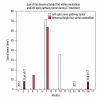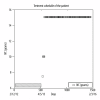High-Dose Intravenous Vitamin C Treatment of a Child with Neurofibromatosis Type 1 and Optic Pathway Glioma: A Case Report
- PMID: 27773919
- PMCID: PMC5081233
- DOI: 10.12659/ajcr.899754
High-Dose Intravenous Vitamin C Treatment of a Child with Neurofibromatosis Type 1 and Optic Pathway Glioma: A Case Report
Abstract
BACKGROUND In neurofibromatosis type 1 (NF1) disease, the loss of the tumor suppressor function of the neurofibromin gene leads to proliferation of neural tumors. In children, the most frequently identified tumor is the optic pathway glioma. CASE REPORT We describe the case of a 5-year-old child who was diagnosed with NF1 and optic pathway tumor onset at the age of 14 months. Because of the tumor progression, chemotherapy with carboplatin and vincristine was prescribed at this early age and continued for one year. As the progression of disease continued after chemotherapy, the child, at the age of 2.8 years, was started on high-dose intravenous vitamin C (IVC) treatment (7-15 grams per week) for 30 months. After 30 months, the results of IVC treatments demonstrated reduction and stabilization of the tumors in the optic chiasm, hypothalamus, and left optic nerve according to radiographic imaging. The right-sided optic nerve mass seen before IVC treatment disappeared by the end of the treatment. CONCLUSIONS This case highlights the positive effects of treating NF1 glioma with IVC. Additional studies are necessary to evaluate the role of high-dose IVC in glioma treatment.
Conflict of interest statement
Conflicts of Interest: None declared
Figures




Similar articles
-
Manifestations and Treatment of Adult-onset Symptomatic Optic Pathway Glioma in Neurofibromatosis Type 1.Anticancer Res. 2019 Feb;39(2):827-831. doi: 10.21873/anticanres.13181. Anticancer Res. 2019. PMID: 30711963
-
Diencephalic syndrome as sign of tumor progression in a child with neurofibromatosis type 1 and optic pathway glioma: a case report.Childs Nerv Syst. 2013 Oct;29(10):1941-5. doi: 10.1007/s00381-013-2109-5. Epub 2013 Apr 25. Childs Nerv Syst. 2013. PMID: 23615855
-
Optic glioma and precocious puberty in a girl with neurofibromatosis type 1 carrying an R681X mutation of NF1: case report and review of the literature.BMC Endocr Disord. 2015 Dec 15;15:82. doi: 10.1186/s12902-015-0076-4. BMC Endocr Disord. 2015. PMID: 26666878 Free PMC article. Review.
-
Concomitant meningioma and glioma within the same optic nerve in neurofibromatosis type 1.J Child Neurol. 2014 Mar;29(3):385-8. doi: 10.1177/0883073812475157. Epub 2013 Feb 17. J Child Neurol. 2014. PMID: 23420652
-
Optic Pathway Glioma and Cerebral Focal Abnormal Signal Intensity in Patients with Neurofibromatosis Type 1: Characteristics, Treatment Choices and Follow-up in 134 Affected Individuals and a Brief Review of the Literature.Anticancer Res. 2016 Aug;36(8):4095-121. Anticancer Res. 2016. PMID: 27466519 Review.
Cited by
-
Metabolic resuscitation in pediatric sepsis: a narrative review.Transl Pediatr. 2021 Oct;10(10):2678-2688. doi: 10.21037/tp-21-1. Transl Pediatr. 2021. PMID: 34765493 Free PMC article. Review.
-
Potential Mechanisms of Action for Vitamin C in Cancer: Reviewing the Evidence.Front Physiol. 2018 Jul 3;9:809. doi: 10.3389/fphys.2018.00809. eCollection 2018. Front Physiol. 2018. PMID: 30018566 Free PMC article. Review.
-
Ascorbate content of clinical glioma tissues is related to tumour grade and to global levels of 5-hydroxymethyl cytosine.Sci Rep. 2022 Sep 1;12(1):14845. doi: 10.1038/s41598-022-19032-8. Sci Rep. 2022. PMID: 36050369 Free PMC article.
-
The Role of 2-Oxoglutarate Dependent Dioxygenases in Gliomas and Glioblastomas: A Review of Epigenetic Reprogramming and Hypoxic Response.Front Oncol. 2021 Mar 25;11:619300. doi: 10.3389/fonc.2021.619300. eCollection 2021. Front Oncol. 2021. PMID: 33842321 Free PMC article. Review.
-
Vitamin C Transporters and Their Implications in Carcinogenesis.Nutrients. 2020 Dec 18;12(12):3869. doi: 10.3390/nu12123869. Nutrients. 2020. PMID: 33352824 Free PMC article. Review.
References
-
- Listernick R, Charrow J. Intracranial gliomas in neurofibromatosis type 1. Am J Med Genet. 1999;89:38–44. - PubMed
-
- Friedman JM, Gutmann DH, MacCollin M, et al. Neurofibromatosis: Phenotype, natural history and pathogenesis. 3rd ed. John Hopkins University Press; Baltimore: 1999.
-
- Listernick R, Charrow J, Greenwald MJ, et al. Optic gliomas in children with neurofibromatosis type 1. J Pediatr. 1989;114:788–92. - PubMed
-
- Listernick R, Louis DN, Packer RJ, et al. Optic pathway gliomas in children with neurofibromatosis 1: Consensus statement from the NF1 Optic pathway glioma Task Force. Ann Neurol. 1997;41:143–49. - PubMed
-
- King A, Listernick R, Charrow J, et al. Optic pathway gliomas in neurofibromatosis type 1: The effect of presenting symptoms on outcome. Am J Med Genet A. 2003;10:1002. - PubMed
Publication types
MeSH terms
Substances
LinkOut - more resources
Full Text Sources
Medical
Research Materials
Miscellaneous

